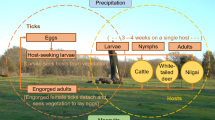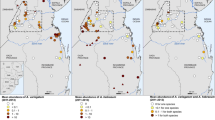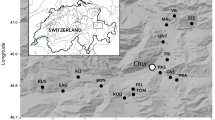Abstract
The autochthonous tick Boophilus decoloratus, and the invasive species Bo. microplus, the tick most threatening the livestock industry in Africa, show complex interactions in their interspecific rivalry. This study was conducted to specify the conditions under which the two competitors can co-exist in equilibrium, and to provide insight into their climate-dependant parapatric distribution in Tanzania. A model of the Lotka-Volterra type was used, taking into account population dispersal and interactions of various kinds. If the model allowed for immunity-mediated competition on cattle, reproductive interference, and an external mortality factor, it explained fairly well the field observation that the borderline between these ticks loosely follows the 22–23°C isotherm and the 58 mm isohyet (i.e. ~700 mm of annual rainfall total). Simulations fully compatible with the pattern of real co-existing populations of Bo. decoloratus and Bo. microplus, characterized by a pronounced population density trough and mutual exclusion of the two ticks on cattle in an intermediary zone between their distributional ranges, were, however, achieved only if the model also implemented a hypothetical factor responsible for some mortality upon encounter of one tick with the other, interpretable as an interaction through a shared pathogen(s). This study also demonstrated the importance of non-cattle hosts, enabling the autochthon to avoid competition with Bo. microplus, for the behaviour of the modelled system. The simulations indicate that a substantial reduction of wildlife habitats and consequently of Bo. decoloratus refugia, may accelerate the replacement of Bo. decoloratus with Bo. microplus much faster than climatic changes might do.









Similar content being viewed by others
References
Amin-Babjee SM, Riek RF (1986) Development of resistance to experimental tick (Boophilus microplus) infestations in European breed cattle. Kaji Vet Malays 18:55–63
Araújo MB, Luoto M (2007) The importance of biotic interactions for modelling species distribution under climate change. Glob Ecol Biogeogr 16:743–753
Arthur DR, Londt JGH (1973) The parasitic cycle of Boophilus decoloratus (Koch, 1844) (Acarina: Ixodidae). J Ent Soc S Afr 36:87–116
Baker JAF, Jordaan JO, Robertson WD (1981) A comparison of the resistance spectra to ixodicides of Boophilus decoloratus (Koch) and Boophilus microplus (Canestrini) in the Republic of South Africa and Transkei. In: Proceedings of a Conference on Tick Biology and Control, Rhodes University, Grahanstown, pp 103–108
Baker JAF, Ducasse FBW, Sutherst RW, Maywald GF (1989) The seasonal tick populations on traditional and commercial cattle grazed at four altitudes in Natal. J S Afr Vet Assoc 60:95–101
Berkvens DL, Geysen DM, Chaka G, Madder M, Brandt JRA (1998) A survey of the ixodid ticks parasitising cattle in the eastern province of Zambia. Med Vet Entomol 12:234–240
Bull CM (1991) Ecology of parapatric distributions. Ann Rev Ecol Syst 22:19–36
Bull CM, Possingham H (1995) A model to explain ecological parapatry. Am Nat 145:935–947
Byrd RH, Lu P, Nocedal J, Zhu C (1995) A limited memory algorithm for bound constrained optimisation. SIAM J Sci Comput 16:1190–1208
Cornell H (1974) Parasitism and distributional gaps between allopatric species. Am Nat 108:880–883
Corson MS, Teel PD, Grant WE (2004) Microclimate influence in a physiological model of cattle-fever tick (Boophilus spp.) population model. Ecol Model 180:487–514
Cumming GS, Van Vuuren DP (2006) Will climate change affect ectoparasite species ranges? Glob Ecol Biogeogr 15:486–497
Estrada-Peña A (2003) Climate change decreases habitat suitability for some tick species (Acari: Ixodidae) in South Africa. Onderstepoort J Vet Res 70:79–93
Friedhoff KT (1988) Transmission of Babesia. In: Ristic M (ed) Babesiosis in domestic animals and man. CRC Press, Boca Raton, pp 23–52
Gothe R (1967) Investigations into the cold resistance of the eggs and larvae of Boophilus decoloratus (Koch, 1844), Boophilus microplus (Canestrini, 1888) and Margaropus winthemi Karsch, 1879. Onderstepoort J Vet Res 34:109–128
Holt RD, Pickering J (1985) Infectious disease and species coexistence: a model of Lotka-Volterra form. Am Nat 126:196–211
Horak IG, DeVos V, Brown MR (1983) Parasites of domestic and wild animals in South Africa, XVI. Helminth and arthropod parasites of blue and black wildebeest (Connochaetes taurinus and Connochaetes gnou). Onderstepoort J Vet Res 50:243–255
Horak IG, Boomker J, Spickett AM, DeVos V (1992) Parasites of domestic and wild animals in South Africa, XXX. Ectoparasites of kudus in the eastern Transvaal Lowveld and the eastern cape province. Onderstepoort J Vet Res 59:259–273
Horak IG, Gallivan GJ, Braack LEO, Boomker J, DeVos V (2003) Parasites of domestic and wild animals in South Africa, XLI. Arthropod parasites of impalas, Aepyceros melampus, in the Kruger National Park. Onderstepoort J Vet Res 70:131–163
Jørgensen SE, Halling-Sørensen B, Nielsen SN (1995) Environmental and ecological modelling. CRC Press, New York
Katsande TS, Mazhowu Turton JA, Munodzana D (1996) Babesia bovis case reports and the current distribution of Boophilus microplus in Zimbabwe. Zimb Vet J 27:33–36
Labruna BM, Naranjo V, Mangold AJ, Thompson C, Estrada-Peña A, Guglielmone AA, Jongejan F, de la Fuente J (2009) Allopatric speciation in ticks: genetic and reproductive divergence between geographic strains of Rhipicephalus (Boophilus) microplus. BMC Evol Biol 9:46
Limpert E, Stahel WA, Abbt M (2001) Log-normal distributions across the sciences: keys and clues. Bioscience 51:341–352
Londt JGH, Arthur DR (1975) The structure of the parasitic life cycle of Boophilus microplus (Canestrini, 1888) in South Africa (Acarina: Ixodidae). J Ent Soc S Afr 38:321–340
Lynen G, Zeman P, Bakuname C, Di Giulio G, Mtui P, Sanka P, Jongejan F (2008) Shifts in the distributional ranges of Boophilus ticks in Tanzania: evidence that a parapatric boudary between Boophilus microplus and Boophilus decoloratus follows climate gradients. Exp Appl Acarol 44:147–164
MacArthur RH (1972) Geographical ecology; patterns in the distribution of species. Princetown University Press, Princetown
Madder M, Thys E, Geysen D, Baudoux C, Horak I (2007) Boophilus microplus ticks found in West Africa. Exp Appl Acarol 43:233–234
Mason CA, Norval RAI (1980) The ticks of Zimbabwe. 1. The genus Boophilus. Zimb Vet J 11:36–43
Mount GA, Haile DG, Davey RB, Cooksey LM (1991) Computer simulation of Boophilus cattle tick (Acari: Ixodidae) population dynamics. J Med Entomol 28:223–240
Norval RAI, Short N (1984) Interspecific competition between Boophilus decoloratus and Boophilus microplus in Southern Africa. In: Griffiths DA, Bowman CE (eds) Acarology VI, vol 2. Ellis Horwood Limited, Chichester, pp 1242–1246
Norval RAI, Sutherst RW (1986) Assortative mating between Boophilus decoloratus and Boophilus microplus (Acari: Ixodidae). J Med Entomol 23:459–460
Norval RAI, Perry BD, Hargreaves SK (1992) Ticks and tick-borne disease control in Zimbabwe: what might the future hold? Zimb Vet J 23:1–15
Nyangiwe N, Horak IG (2007) The species composition and seasonal abundance of free-living ticks on Döhne Sourveld and eastern province Thornveld. East Cape Res Bull 2:1–6
Rechav Y, Clarke FC, Dauth J (1991) Acquisition of immunity in cattle against the blue tick, Boophilus decoloratus. Exp Appl Acarol 11:51–56
Ribeiro JMC, Spielman A (1986) The satyr effect: a model predicting parapatry and species extinction. Am Nat 128:513–528
Short NJ, Floyd RB, Norval RA, Sutherst RW (1989) Development rates, fecundity and survival of developmental stages of the ticks Rhipicephalus appendiculatus, Boophilus decoloratus and B. microplus under field conditions in Zimbabwe. Exp Appl Acarol 6:215–236
Solomon G, Kaaya GP (1998) Development, reproductive capacity and survival of Amblyomma variegatum and Boophilus decoloratus in relation to host resistance and climatic factors under field conditions. Vet Parasitol 75:241–253
Sutherst RW (1985) The role of models in tick control. Austr Vet J 62(S1):32–37
Sutherst RW (1987) The dynamics of hybrid zones between tick (Acari) species. Int J Parasitol 17:921–926
Sutherst RW, Maywald GF (1985) A computerised system for matching climates in ecology. Agr Ecosyst Environ 13:281–299
Sutherst RW, Maywald GF, Bourne AS (2007) Including species interactions in risk assessment for global change. Glob Chan Biol 13:1843–1859
Teel PD, Marin SL, Grant WE (1996) Simulation of host-parasite interactions: influence of season and habitat on cattle-fever tick (Boophilus sp.) population dynamics. Ecol Model 84:19–30
Tønnesen MH (2002) Distribution of Boophilus microplus and Boophilus decoloratus and associated occurrence of Babesia species in cattle in the Soutpansberg Region, Northern Province, South Africa. PhD Thesis, Faculty of Veterinary Sciences, University of Pretoria
Tønnesen MH, Penzhorn BL, Bryson NR, Stoltsz WH, Masibigiri T (2004) Displacement of Boophilus decoloratus by Boophilus microplus in the Soutpansberg region, Limpopo Province, South Africa. Exp Appl Acarol 32:199–209
Tyre AJ, Tenhumberg B, Bull CM (2004) The role of local spatial heterogeneity in the maintenance of parapatric boundaries: agent based models of competition between two parasitic ticks. In: Pahl-Wostl C, Schmidt S, Rizzoli AE, Jakeman AJ (eds) Complexity and integrated resources management, Trans 2nd Bienn Meeting iEMSs, pp. 1–7
Yeoman GH, Walker JB (1967) The Ixodid ticks of Tanzania: a study of the zoogeography of the Ixodidae of an East African country. Commonwealth Institute of Entomology, London
Acknowledgments
This study was conducted under the sponsorship of The Integrated Consortium on Ticks and Tick-borne Diseases (ICTTD-3), an European Union-funded international cooperation programme (coordination action project no. 510561). Prof. I.G. Horak, University of Pretoria, South Africa, and Dr. M.H. Tønnesen, Norwegian Food Safety Authority (Mattilsynet), Førde, Norway, are thanked for contributing with data on co-existing Boophilus ticks in South Africa.
Author information
Authors and Affiliations
Corresponding author
Rights and permissions
About this article
Cite this article
Zeman, P., Lynen, G. Conditions for stable parapatric coexistence between Boophilus decoloratus and B. microplus ticks: a simulation study using the competitive Lotka-Volterra model. Exp Appl Acarol 52, 409–426 (2010). https://doi.org/10.1007/s10493-010-9376-6
Received:
Accepted:
Published:
Issue Date:
DOI: https://doi.org/10.1007/s10493-010-9376-6




